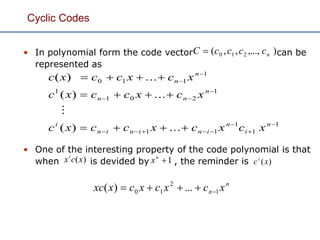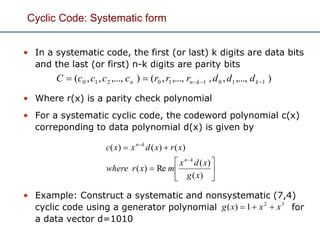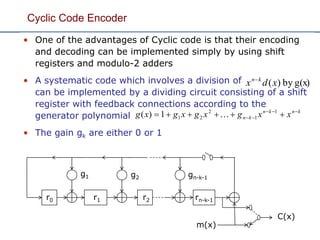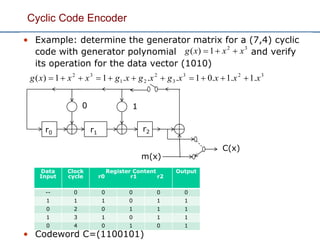Digital Communication: Channel Coding
- 1. Digital Communication Dr. S. M. Gulhane Principal, Pravara Rural Engineering College, Loni, Ahmednagar Savitribai Phule Pune University, Maharashtra, India Unit-2 : Channel Coding 1 1 0 0 1 1 0 1 1 0 0 0 1 Channel Coding
- 2. Channel Coding 2 • Channel coding provides to the receiver the ability of error detection and correction • Channel Encoder adds some redundant bits to the input bit sequence. Addition of these extra bits • Allows the receiver to perform error detection and correction • However, increases the bit rate and hence increase required bandwidth
- 3. Types of Error Control • Error detection and retransmission The receiver does not attempt to correct the error The receiver simply requests a retransmission Require full duplex connection Example: o Automatic Retransmission reQuest (ARQ) • Forward error correction (FEC) The receiver can correct and detect the errors Require Simplex Connection Example: o Block Codes o Convolutional Codes
- 4. 4 Linear block codes • The information bit stream is divided into blocks of k bits. • Each block is encoded to a larger block of n bits. • The coded bits are modulated and sent over channel. • The reverse procedure is done at the receiver. • Structure of Codeword Data block Channel encoder Codeword k bits n bits p1, p2,……pn-k m1m2,….mk n-k parity bits k message bits n bit codeword
- 5. Error Control Coding • A binary block code generates a block of n coded bits from k information bits. We call this an (n,k) binary block code. • The n codeword symbols can take on 2n possible values corresponding to all possible combinations of the n binary bits. • 2k codewords from these 2npossibilities is to be selected to form the code, such that each k bit information block is uniquely mapped to one of these 2k codewords. • A code is said to be linear if addition (modulo-2 adition) of any two codewords in the code produce a third code word in the code • A code is systematic code, if the first (or last) k elements in the codeword are information bits 5
- 6. Linear Block Code • The encoding operation of Linear Block code involve two operations Segmentation of information sequences Transformation of each message block into a block of n bits according to some predetermined set of rules • Consider Message block Each message bit can be 0 or 1 => 2k distinct message blocks • Each message block is transformed to codeword C of length n bits • There will be 2k distinct codewords, one unique codeword for each distinct message 6 ),...,,,,...,,(),...,,( bitsmessage 21 bitsparity 2121 kknn mmmpppcccC ),...,,( 21 kmmmm ),...,,( 21 ncccC
- 7. Linear Block Code • In Systematic block code • In matrix form 7 ,...,1, ......... ......... ,22,11, ,12121111 nknknfor imc and mpmpmpc mpmpmpc ii kknkkkkn kkn 100 010 001 ][ ,21 ,22221 ,11211 21 knkkk kn kn k ppp ppp ppp mmmC
- 8. Linear Block Code • 8 mGC matrixParity)( matrixidentity matrixGenerator][ knk kkk nkk P I IPG 100 010 001 ,21 ,22221 ,11211 knkkk kn kn k ppp ppp ppp IPG
- 9. Linear Block Code • The generator matrix is a compact description of how codewords are generated from information bits in a linear block code. • The design goal in linear block codes is to find generator matrices such that the corresponding codes are easy to encode and decode yet have powerful error correction/detection capabilities. • Tradeoffs between Efficiency Reliability Encoding/Decoding complexity 9
- 10. Linear Block Code • Parity Check Matrix: Associated to each (n,k) linear block code there is a parity check matrix H at the decoder. • Parity check matrix H has its rows orthogonal to rows of G such that • The parity check matrix H is used to detect errors in the received code • C is the codeword in (n,k) block code generated by G iff 10 0T GH nkn T kn PIH , 0T CH
- 11. Linear Block Code • Let R = C + E be the received message where C is the correct code and E is the error • Decoding operation is done by determining syndrome vector S as • If R is a valid vector then syndrome of received vector S is 0 • Nonzero S indicates that there are errors in transmission • Thus S is used to detect the errors. It is also used to correct the errors. • The errors can be corrected at the receiver by comparing S with the rows of and correcting the ith received bit if S matches with the ith row of 11 T TT T EH EHCH RHS T H T H
- 12. Linear Block Code Operations of the generator matrix and the parity check matrix • Example1: For a (6,3)LBC with generator matrix G, find codeword for all the distinct messages. 12 1 0 0 0 1 0 0 0 1 1 1 0 0 1 1 1 0 1 G
- 13. 13 Linear Block Code • Example: Block code (6,3) 1 0 0 0 1 0 0 0 1 1 1 0 0 1 1 1 0 1 G 1 1 1 1 1 0 0 0 0 1 0 1 1 1 1 1 1 0 1 1 0 0 0 1 1 0 1 1 1 1 1 0 0 0 1 1 1 1 0 0 0 1 1 0 1 0 0 0 1 0 0 0 1 0 1 0 0 1 1 0 0 1 0 0 0 0 1 0 0 0 1 0 Message vector Codeword
- 14. Linear Block Code • In polynomial form the codeword c(x) can be written as c(x) = m(x) g(x) • where m(x) is the message polynomial and g(x) is the generator polynomial, G is the generator matrix. • G = [P | I], • where Pi = Remainder of [xn-k+i-1/g(x)] for i=1, 2, .., k, and I is unit matrix. 14 knkkk kn kn k ppp ppp ppp P P P P ,21 ,22221 ,11211 2 1
- 15. Linear Block Code • Example 2: Find linear block code encoder G if code generator polynomial g(x)=1+x+x3 for a (7, 4) code. • We have • n = Total number of bits = 7, • k = Number of information bits = 4, • r = Number of parity bits = n - k = 3. 15 1000 0100 0010 0001 4 3 2 1 P P P P IPG kiP xg x i ikn ,...,2,1,ofderminRe )( 1
- 17. • Example 3: Suppose that codeword U=101110 is transmitted and the vector r=001110 is received. That means the leftmost bit is received in error. Find the syndrome vector value S=rHT and verify that is equal to eHT. 001011 010110 100101 H
- 18. Error detection and error correction capabilities • Some important terms: • Hamming Weight or Weight of a code vector : Number of nonzero components in codeword • Hamming distance: Hamming distance between two codewords is the number of components in which they differ. • Minimum distance: Smallest distance between any pair of codewords in the code The ability of a code to detect and correct the errors can be specified in terms of minimum distance of the code • Theorem: The minimum distance of a LBC is equal to the minimum weight of any nonzero codeword in the code. • Example4: For the code in example1 find out weights of codewords and the minimum distance of the code. )()( VUVU, wd
- 19. Error detection and error correction capabilities of LBC • Theorem: A LBC with a minimum distance dmin can detect upto dmin -1 errors and correct upto [(dmin -1)/2] errors. Where [(dmin -1)/2] denotes the largest integer not greater than (dmin -1)/2. • Proof: Let C be the transmitted codeword and R is the received codeword. Let C’ be the any other codeword in the code. • Then the Hamming distance between codeword d(C,C’), d(C,R) and d(C’,R) satisfy d(C,R)+ d(C’,R) ≥ d(C,C’) … 1 Let the received vector consist of t errors i.e. d(C,R)=t Let dmin be the minimum distance of the code d(C,C’) ≥ dmin
- 20. 20 • Hamming codes Hamming codes are a subclass of linear block codes. It is a single error correcting perfect code. To correct a single error LBC must have a minimum distance dmin =3. The LBC code for which t=1 and dmin=3 is called Hamming code. Hamming codes have following attributes Hamming Codes are simple to construct Hamming codes t mk n m m 1:capabilitycorrectionError 3d:distanceMinimum 12:bitsninformatioofNumber 12:lengthCode 3k-nm:bitsparityofnumber min
- 21. • For a LBC code, the required no. of bits in the codeword for the message block size k is given by • Proof: Occurrence of single error in the ith bit of codeword implies that the syndrome of received vector is equal to the ith row of HT Since we have n rows in HT, for the syndrome of all single errors to be distinct, n rows of HT should be distinct. While choosing H following points should be consider There should not be a row of zeros since syndrome of 0 error does not correspond to error. The last n-k rows of HT must be chosen to form identity matrix Each rows of HT has n-k entries which implies 2n-k distinct rows out of which we can use 2n-k -1 distinct rows Since matrix has n rows, for all of them to be distinct, we need )1(log2 nkn LBC encoder design )1(log)1(log12 22 nknnknnkn
- 22. • Design a LBC code with a minimum distance of 3 and a message block size of eight bits • N=12 satisfies the above inequality • Need (12,8) block code • P is 8x4 size • The first 8 rows of HT are arbitrarily chosen such that All the 8 rows must be distinct No row is zero row )1(log2 nkn LBC encoder design knxnkn T I P H
- 23. Design the (n,k) code 1. The number of codewords is 2k 2. The all-zeros vector must be one of the codewords 3. The property of closure must apply. The sum of any two codewords in the space must yield a valid codeword in the space 4. Each codeword is n bits long 5. Since , the weight of each codeword must also be at least 6. Assume the code is systematic, and the rightmost k bits of each codeword are the corresponding message bits. 12 2 1 min k k n d
- 24. 24 • Example: For a (6,3) code, the generator matrix Find the codewords corresponding to each distinct messages Verify that this code is a single error correcting code Draw the encoder circuit Determine the syndrome vector for the received vector r=101101. determine the corresponding data word Realize the syndrome encoder circuit LBC encoder and Decoder 2 1 1 1 0 1 0 1 0 1 1 0 0 0 1 0 0 0 1 min dG PIk :G kn T IPH : kn T I P H 0 1 1 1 0 1 1 1 0 1 0 0 0 1 0 0 0 1 G
- 25. 25 Linear block codes – Syndrome decoding 111010001 100100000 010010000 001001000 110000100 011000010 101000001 000000000 (101011)(001000)(100011)ˆˆ estimatedisvectorcorrectedThe (001000)ˆ issyndromethistoingcorrespondpatternError (110)(100011) :computedisofsyndromeThe received.is(100011) er e HrHS r r C TT Error pattern Syndrome
- 26. Example: • Consider a systematic linear block codeword whose parity-check equations are p1=m1+m2+m4, p2=m1+m3+m4, p3=m1+m2+m3, p4=m2+m3+m4 where mi are message digits and pi are check digits. (a) Find the parity-check matrix and the generator matrix for this code. (b) Is the vector 10101010 a codeword? (c) How many errors can the code correct?
- 27. Cyclic Codes • Cyclic codes form subclass of linear block codes • Implementation of LBC is relatively simple for single error correction. However it is too dificult for higher order error corrections. • Cyclic code has a simple mathematical structure that permits design of higher order error correcting codes • The encoder can be realized by simply using shift registers. • A binary code is said to be cyclic if it exhibits the two following properties the sum of any two code words in the code is also a code word (linearity) any cyclic shift of a code word in the code is also a code word (cyclic)
- 28. Cyclic Codes • In Cyclic codes the codewords in the code set are simple lateral shifts of one another such that • Where denotes cyclic shift of C by i places to the left. • Cyclic codes are described in a polinomial form • This polinomial representation of cyclidc codes is useful in analysis and implementation of the code • code vector can be expressed as the (n-1) degree polynomial ),,,...,,( ),...,,( 2121 )( 21 inii i n ccccccCthen cccCif )(i C ),...,,( 21 ncccC
- 29. Cyclic Codes • In polynomial form the code vector can be represented as • One of the interesting property of the code polynomial is that when is devided by , the reminder is 1 1 1 11 1 201 1 1 110 ...)( ...)( ...)( n i n ininin i n nn n n xcxcxccxc xcxccxc xcxccxc ),...,,,( 210 nccccC )(xcxi 1n x )(xci n n xcxcxcxxc 1 2 10 ...)(
- 30. Cyclic Codes • Theorem: if g(x) is a polynomial of degree (n-k) and is a factor of xn+1, then g(x) generates an (n,k) cyclic code for which the code polynomial can be generated as • This is the nonsystematic form of cyclic code )(1 xc kn kn k k xgxdxggand xdxdxddxdwhere 2 110 1 1 2 110 g(x) )( 1 1 2 2 101 11 11 1 2 2 10 n nn n nn n n n n n n xcxcxcc xcc cxcxcxcxcx )1( )()( )( Rem)( )()1)(()( n i x xcxi ini xc xcxxqxcx )()()( xgxdxc
- 31. Cyclic Code: Systematic form • In a systematic code, the first (or last) k digits are data bits and the last (or first) n-k digits are parity bits • Where r(x) is a parity check polynomial • For a systematic cyclic code, the codeword polynomial c(x) correponding to data polynomial d(x) is given by • Example: Construct a systematic and nonsystematic (7,4) cyclic code using a generator polynomial for a data vector d=1010 )( )( Re)( )()()( xg xdx mxrwhere xrxdxxc kn kn 32 1)( xxxg ),...,,,,...,,(),...,,,( 110110210 kknn dddrrrccccC
- 32. Cyclic Code: Symmetric form • Given • Systematic code is expressed as • Nonsystematic code 1001010C .0.1.0.1.0.0.11 1)1()( 1 )( )( Re)( )()()( 6543253 23 3 xxxxxxxx xxxc xg xdx mxrwhere xrxdxxc kn 2 32 1)( 1)( xxd xxxg 1001010C 1 )1)(1( )()()( 543 322 xxx xxx xgxdxc
- 33. Generator Matrix of Cyclic Code • Cyclic code can also be described by generator matrix • Where the parity matrix P is determined as • Example: determine the generator matrix for a (7,4) cyclic code with generator polynomial )( Reofrow )( Reofrow2 )( Reofrow1 2 1 xg x mPkth xg x mPnd xg x mPst kn n n kkknknk IPG )( 1)( 23 xxxg
- 34. Cyclic Code Encoder • One of the advantages of Cyclic code is that their encoding and decoding can be implemented simply by using shift registers and modulo-2 adders • A systematic code which involves a division of can be implemented by a dividing circuit consisting of a shift register with feedback connections according to the generator polynomial • The gain gk are either 0 or 1 knkn kn xxgxgxgxg 1 1 2 211)( g(x)by)(xdx kn r0 r1 r2 gn-k-1g2 g1 rn-k-1 m(x) C(x)
- 35. Cyclic Code Encoder • Example: determine the generator matrix for a (7,4) cyclic code with generator polynomial and verify its operation for the data vector (1010) • Codeword C=(1100101) 323 3 2 21 32 .1.1.01...11)( xxxxgxgxgxxxg Data Input Clock cycle Register Content r0 r1 r2 Output -- 0 0 0 0 0 1 1 1 0 1 1 0 2 0 1 1 1 1 3 1 0 1 1 0 4 0 1 0 1 32 1)( xxxg r2 10 m(x) C(x) r0 r1
- 36. Cyclic Code Decoder • Every valid codeword polynomial c(x) is a multiple of g(x) • If an error occures during the transmission,the received code polynomial r(x) will not be a multiple of g(x), then • s(x) is a syndrome polynomial and has a degree n-k-1 or less • If e(x) is the code polynomial then r(x)=c(x)+e(x) g(x) r(x) Rems(x) g(x) s(x) )( g(x) r(x) where xm )( )( Re )( )()( Re )( )( Re)( xg xe m xg xexc m xg xr mxs
- 37. Cyclic Codes • The polynomial plays major role in the generation of cyclic codes • If we have a generator polynomial g(x) of an (n,k) cyclic code with certain k polynomials, we can create the generator matrix (G) • Syndrome polynomial of the received code word corresponds error polynomial • Other remarkable cyclic codes are Cyclic redundancy check (CRC) codes Bose-Chaudhuri-Hocquenghem (BCH) codes Reed-Solomon codes







![Linear Block Code
• In Systematic block code
• In matrix form
7
,...,1,
.........
.........
,22,11,
,12121111
nknknfor imc
and
mpmpmpc
mpmpmpc
ii
kknkkkkn
kkn
100
010
001
][
,21
,22221
,11211
21
knkkk
kn
kn
k
ppp
ppp
ppp
mmmC](https://image.slidesharecdn.com/unit5dcerrorcodingclasssmg-191011220545/85/Digital-Communication-Channel-Coding-7-320.jpg)
![Linear Block Code
•
8
mGC
matrixParity)(
matrixidentity
matrixGenerator][
knk
kkk
nkk
P
I
IPG
100
010
001
,21
,22221
,11211
knkkk
kn
kn
k
ppp
ppp
ppp
IPG](https://image.slidesharecdn.com/unit5dcerrorcodingclasssmg-191011220545/85/Digital-Communication-Channel-Coding-8-320.jpg)




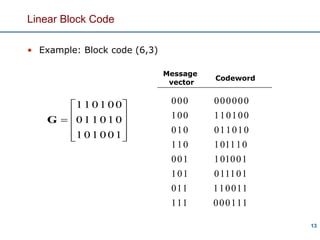
![Linear Block Code
• In polynomial form the codeword c(x) can be written as
c(x) = m(x) g(x)
• where m(x) is the message polynomial and g(x) is the
generator polynomial, G is the generator matrix.
• G = [P | I],
• where Pi = Remainder of [xn-k+i-1/g(x)] for i=1, 2, .., k, and I
is unit matrix.
14
knkkk
kn
kn
k ppp
ppp
ppp
P
P
P
P
,21
,22221
,11211
2
1
](https://image.slidesharecdn.com/unit5dcerrorcodingclasssmg-191011220545/85/Digital-Communication-Channel-Coding-14-320.jpg)




![Error detection and error correction capabilities of LBC
• Theorem: A LBC with a minimum distance dmin can detect
upto dmin -1 errors and correct upto [(dmin -1)/2] errors.
Where [(dmin -1)/2] denotes the largest integer not greater than
(dmin -1)/2.
• Proof:
Let C be the transmitted codeword and
R is the received codeword.
Let C’ be the any other codeword in the code.
• Then the Hamming distance between codeword d(C,C’),
d(C,R) and d(C’,R) satisfy
d(C,R)+ d(C’,R) ≥ d(C,C’) … 1
Let the received vector consist of t errors i.e. d(C,R)=t
Let dmin be the minimum distance of the code
d(C,C’) ≥ dmin](https://image.slidesharecdn.com/unit5dcerrorcodingclasssmg-191011220545/85/Digital-Communication-Channel-Coding-19-320.jpg)









